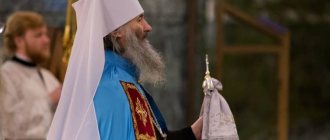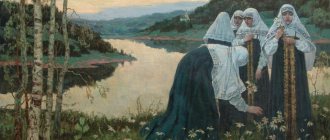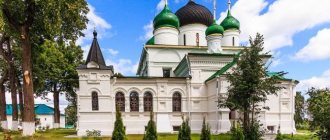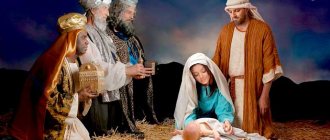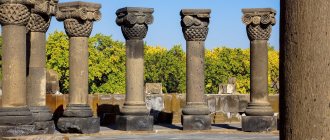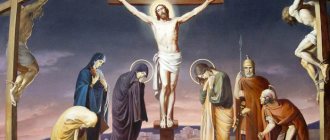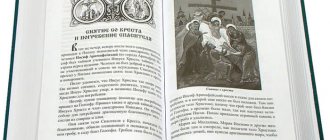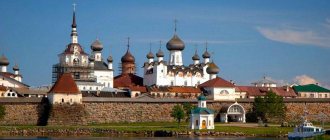What is a monastery?
A monastery is a home for monks: their family, apartment and fortress. This is a tiny city with its own way of life and regulations. This is a settlement where everyone is united by one thing - life for God and the unceasing memory of Him. This is a monastery in which monks, without denying modern state laws, live for the sake of spiritual laws.
Monasteries can be located anywhere (within the city, next to it, or far from any populated area - for example, on rocks).
Monasteries can be of different sizes: from a tiny courtyard with several monks to a large Lavra, where the brethren can number hundreds of monks.
Monasteries can be male or female. Monasteries can have, in fact, a variety of external features, architecture and forms, but they all have one thing in common: this is a place where people gather who have left the world in spirit. Those who left everything in the world - things, attachments, earthly claims - leaving there, in essence, their former selves and thereby finding a new selves.
For monks, the monastery is a fence and support in their New Life, which ideally should be equal to the angels.
See also: Why do people join a monastery and who are monks?
For “laity”, a monastery is an opportunity to come into contact with a “different” world: to see with their own eyes a life built not according to the principles and aspirations of secular existence, but according to the principles of spiritual, Gospel life.
After all, what is a monastery in essence? This is a piece of the heavenly, mountainous world on our earth. A place where the Holy Spirit breathes and sanctifies everyone who enters and, even more so, who lives there.
Mozhaisk Luzhetsky Ferapontov Monastery.
"If you want to be perfect..."
Theodosius was born around 424 in Cappadocia into a Christian family. As a child, he sang in church, studied from the Psalter and the Gospel and dreamed of exploits in the name of Christ, and after a pilgrimage to Jerusalem, to holy places, he finally decided to become a monk. I found a suitable monastery near Metope (now Umm Tuba, an Arab region in eastern Jerusalem) and began to study the “canon of the desert”, and then headed east into the desert, found at the top of one of the mountain ridges a cave in which, according to legend, The Gospel Magi spent the night on their way back from Bethlehem, and settled there as a hermit.
But even great hermits rarely remained in solitude all their lives. Usually people began to come to them who wanted to learn spiritual life from them. They settled not far from the elder, gradually forming monastic settlements in which the monks, although they lived separately, still formed a brotherhood that gathered for common prayer and was united by a common spiritual father. So over time, students began to flock to Theodosius.
How do they live in the monastery?
Each monastery may have its own order of life (in other words, the charter). In some monasteries he is stricter, in others he is “softer”. Within the same monastery, different monks lead different levels of prayer and ascetic life - each according to his strength, each according to his calling.
Despite all the differences that are possible in the structure of monastic life, all monasteries are united by one thing: prayer and divine services occupy a central place in the daily routine and life of the monks. In monasteries, unlike non-monastic, “parish” churches, a full daily cycle of services is held, and the services themselves last longer.
In general terms, a day in a monastery might look like this:
- Five or six o'clock in the morning: the beginning of morning services. Their duration depends on the day or charter of the monastery. On ordinary days, morning services may end at nine; on holidays, they may continue until noon.
- After morning service: breakfast, meal
- Then: a short rest and a time of obedience (obedience is an integral part of monastic life, for idleness is the main enemy of a monk. During obedience, someone monitors the cleanliness of the territory, someone looks after the garden, someone carries out carpentry work, someone... then he works in a stable - and so on).
- In the middle of the day: meal (lunch), then - continuation of obediences.
- At approximately four or five o'clock in the afternoon, evening services begin, which can also last three hours or longer, depending on the day.
- After the evening service - meal, short rest
- Before going to bed - a general or cell prayer rule.
“The multitude of believers had one heart and one soul”
Pachomius himself founded 9 cinemas. Under him, such monastic hostels spread throughout Egypt, and then throughout Palestine.
But Theodosius found it difficult to imitate him. The place he chose for the monastery was sharply different from those in which most of the laurels were located: instead of a stone desert, there was an open mountainous hill with fertile soil. And he set the monks the most difficult task: to combine the contemplative life of a hermit with work for the benefit of their neighbors.
There was no closed and solitary life here: next to the cells, with the blessing of Theodosius, shelters were built for the poor and needy, who flocked here in large numbers, especially in famine years - the rule of the monastic charter, which ordered the reception of all who came, was strictly observed.
The Monk Cassian the Roman wrote that “this kind of life” - communal life - “received its beginning with the apostolic preaching,” since this way of life was adhered to by the entire multitude of believers in Jerusalem. The Acts of the Apostles says: Now the multitude of believers had one heart and one soul; and no one called anything of his property his own, but they had everything in common... There was no one in need among them, for everyone who owned lands or houses, selling them, brought the price of what was sold and laid them at the feet of the Apostles; and to everyone was given what anyone needed (Acts. 4:32, 34–35).
Lavra of Theodosius the Great. Photo: Anton Pospelov, pravoslavie.ru
The brethren of the monastery of St. Theodosius grew quickly - the number of monks in it reached 700. These were people of various nationalities; it was necessary to build four churches inside the monastery: for Greeks, for Georgians, for Armenians and for brothers “possessed by evil demons.”
Who lives in the monastery?
Those who live in monasteries are called inhabitants of the monastery. This:
Actually the monks
Unlike pre-revolutionary times, now there are no rules about how many monks there should or should not be in a monastery. Life determines everything.
Monks are the “spiritual backbone” of any monastery. We wrote about what degrees of monasticism there are and about monasticism in general here.
Novices
Who are the novices? These are people who are preparing to become monks, but according to the abbot, they are not yet ready for this. At the same time, the monastery already bears spiritual responsibility for the novice.
Monks from Holy Mount Athos, first half of the 20th century. Second from left: Venerable Silouan of Athos.
Workers
Who are the workers? Roughly speaking, the same novices, only at the very beginning of their journey. They live with everyone in the same way, perform obediences, and work in the same way.
At the time of entering the monastery, a trudnik is just as sure that he is destined for monasticism, but, as practice shows: since not every novice eventually becomes a monk, then among trudniks this percentage is even smaller. The first inspiration passes, and the person already understands that he had a completely wrong idea about monasticism or his powers - and returns to the world. Or he goes to try himself in another monastery.
Guests, pilgrims
These are even more “temporary” “guests” for the monastery. Although there were cases that it was from a random “guest” who found himself in the monastery out of need, or a pilgrim, that a monk was eventually born.
Desert Fathers
Usually the founders of new Palestinian monasteries took one of the existing monasteries as a model. The first such monastery (i.e., a cenobitic monastery) was established back in the 4th century by the Monk Pachomius the Great, who also began his feat with hermitage. But he saw that a solitary lifestyle was unbearable and not useful for beginners. One must prepare gradually for the creative freedom of hermitage, and the Monk Pachomius organized a hostel in Tavenissi, in Upper Egypt, on the basis of strict obedience. The basis of his school was fidelity to the established rules to the smallest detail, with the complete cutting off of one’s will or self-will.
Appearance of the angel to Pachomius
The Pachomius Monastery was an educational institution where even those ignorant of the faith were accepted. Purity and firmness of intentions were tested by strict testing. The novice entered under the guidance of one of the older brothers. The monks lived in separate houses, about 40 people each, under the leadership of a chief. They gathered together to pray. Handicraft was strictly defined; it could not be arbitrarily reduced, changed, or even increased. It was a common life, a common feat in mutual concerns, where nothing should have been hidden.
What kind of buildings are there in monasteries?
In fact, the only thing that must be required in a monastery is at least one temple and a house where the monks will live. The room in which a monk lives is called a cell.
Otherwise, everything depends on the size of the monastery and its location.
The small monastery of St. George in Bulgarian Pomorie.
But let's take an “average” idea of the monastery. It could have such buildings and structures.
- The territory itself
(it is fenced. In Russia, monasteries used to play the role of fortresses, and therefore their walls were stone, strong and high. For example, the Holy Trinity Lavra of St. Sergius held the siege of the Poles for several months, and they were never able to take it). - Central temple
(cathedral). The place where either the main or, with few exceptions, all services take place. - Another temple
(in large monasteries there may be two, three, or as many as you like). As a rule, it is used rarely - on the days of the largest holidays and on other days that are significant for the monastery. - Fraternal Corps
. This is the house where the cells are located - the rooms of monks and novices. - Refectory
(dining room). Sometimes it is located in a residential, fraternal, building. - Guest House.
Maybe very small, or maybe a large multi-story building. There are separate guest houses for monks and bishops from other monasteries. - Canteen for pilgrims.
- Church shop -
candles, icons, books, church utensils for sale. - Other buildings.
They can house anything - from a Sunday school to a monastery publishing house.
Bulgaria. Pomorie. Monastery of St. St. George the Victorious. Typical territory of a small monastery. On the right is the fraternal building.
Recommendations
- Evangelisti, Silvia (2008). Nuns: A History of Monastic Life, 1450-1700.
. Oxford University Press. paragraphs 38-39. ISBN 9780199532056. Finally, regardless of religious belief, convents remained a possible model for women, both Catholic and Protestant. In Protestant Germany, forms of women's religious associative life did not disappear, but survived in the form of Protestant monasteries. They could be governed by a Lutheran abbess, and were inhabited by Lutheran nuns of religious habits, who claimed to belong to a monastic order, paradoxically. - See This on the line
How many monasteries are there in Russia?
The number of Orthodox monasteries in Russia is constantly growing. Now there are more than 800 of them. In 1986 there were less than twenty.
The main monastery in Russia is the Holy Trinity Sergius Lavra.
One of the oldest monasteries in Russia is the Nikitsky Monastery in Pereslavl-Zalessky.
Military significance of the garrison of the Solovetsky Monastery and the abbot-voevoda
The history of the Solovetsky Monastery, which was actually the main outpost of the Russian state on the White Sea, is considered to be the most eventful with military events. A military garrison on Solovki appeared after 1571, the number of archers reached 1000. The abbots themselves acquired cannons and built fortifications. Thanks to this, the Solovetsky Monastery successfully repelled the onslaught of the Swedes in 1582 and 1611. “The Solovetsky monks became so familiar with military affairs that they found it possible to ask Tsar Mikhail Fedorovich no longer to appoint special governors to the Sumy fort to manage and command the monastery and “arrival archers”, but to leave this matter to the Solovetsky abbot and the brethren,” wrote church historian Archpriest John Syrtsov. — In 1637, the last governor, Timofey Krapivin, handed over all written files, prison keys, and all the weapons to the Solovetsky abbot Bartholomew and went to Moscow forever. Now the Solovetsky rector has literally become the “northern governor.” Since 1654, due to the Swedish threat and the small number of archers, the monks themselves had to learn the art of war. A written military “schedule” appeared on Solovki, where responsibilities were distributed among 425 monks placed “under arms”. The elders and their henchmen were “assigned” to different towers with cannons. As a result, the monks not only learned to wield weapons, but also “to a certain extent adopted the spirit of military courage and courage.” And given the religious fanaticism characteristic of many of them, warrior-monks who were not afraid of death were a formidable force. However, instead of fighting the foreigners, the monks soon turned their weapons against the royal archers. Not accepting the reforms of Patriarch Nikon, the Solovetsky Monastery rebelled, and from 1668 to 1676 successfully defended itself against Moscow troops. Only with the help of a 10,000-strong army did voivode Ivan Meshcherinov finally manage to take Solovki. At the same time, almost all the schismatic monks died - out of 700 inhabitants of the monastery, only 14 people survived.
Founders of the Kiev-Pechersk Monastery
The founders of the Kiev-Pechersk Monastery were two monks - Saint Anthony and Theodosius
. Anthony loved to travel from a young age. He was a devout and pious man. Wandering around Greece, Anthony reached the holy mountain, where there were several monasteries. He liked life in the monastery. And he wanted to become a monk. The abbot explained to him all the rules of monastic life and, after that, tonsured him as a monk. Upon returning to his homeland, Anthony settled in a secluded cave. And he began to lead a hermit’s life.
Meanwhile, when people learned about his way of life, they began to ask him to settle. Nikon was the first to settle near him, and later, in 1032, Theodosius came.
Vvedenskaya Optina Pustyn
This one of the oldest monasteries is located near the city of Kozelsk. According to legend, it was founded by a repentant robber named Opta.
In 1821, a monastery appeared here, and hermits settled in it. People from all over Russia reached out to them, trying to get answers to their questions and healing. After the death of his son F.M. Dostoevsky stayed in the monastery for 3 days.
The monastery became famous for the Optina elders, who became the comforters of the people. After the revolution, Optina Pustyn was closed; it housed a rest home, a concentration camp, and a hospital. In 1987 it was returned to the church.
“The importance of monasteries for our region cannot be overestimated”
We met with Bishop Theoktist of Pereslavl and Uglich at the Epiphany Convent of Uglich, where we providentially found ourselves on the day of the transfer of the relics of Tsarevich Dimitri from Uglich to Moscow (1606). On the territory entrusted to the care of His Eminence, the diocese with a population of 120,000 people contains 10 monasteries and more than 200 churches. The region, traditionally attractive for pilgrims and tourists - the diocese includes five districts of the Yaroslavl region - is again preparing to receive guests from the capital and other Russian cities. This summer, when a significant part of Russians spend their holidays in their country, the flow of tourists is unlikely to decrease. We asked Bishop Theoktist to talk about how the inhabitants of the monasteries relate to the need to host numerous guests; about the educational activities of ancient monasteries and the spiritual meaning of obedience.
The Bishop, monasteries and temples of Pereslavl and Uglich are visited annually by a large number of pilgrims and tourists. There are unlikely to be fewer people wanting to pray at the shrines and see the majestic architectural ensembles of Ancient Rus' this summer. Tell me, do numerous guests interfere with the spiritual life of monastery residents?
When a person decides to become a monk and begins to think about which monastery to enter, he, of course, must take into account the characteristics of a particular monastery, which have developed under the influence of the historical, cultural or geographical conditions of its existence. Maybe someone will disagree with me, but I see our Orthodox monasticism as not at all homogeneous. Within the Russian Orthodox Church there are many monasteries that are very different in terms of their structure. Their charters, history, traditions sometimes differ quite significantly from each other... And these differences were not invented artificially, they were laid down by the founders of these monasteries themselves.
Holy Trinity Danilov Monastery
For example, the Danilov Monastery in Pereslavl, founded by Daniil of Pereslavl, was traditionally engaged in social service. The Monk Daniel gave very specific rules and instructions to the brethren regarding this ministry. He himself took care of people who had no one to take care of - he buried the dead who had left no funds for burial, preached a sober lifestyle (he did not even bless the storage of any wine in the monastery, except for what was used in worship), and today the monastery continues the traditions its founder - is engaged in social and educational activities. I am convinced that the life of a monastery is only prosperous when the monastery fulfills the behests of its founder.
If a person who decides to become a monk comes to one of the Pereslavl or Uglich monasteries, this means that he will work in a monastery located in a tourist place and must be ready for missionary service. For a person who, by his nature, is inclined to solitude, it is probably better to look for another place for monastic achievement. In our country there are dioceses remote from the central part of Russia, whose monasteries will gladly accept novices, there are monasteries remote from the bustle of the world... In a word, there are many opportunities for a solitary prayer life, but the inhabitants of monasteries that are located in historically significant places do not have the opportunity to hang put a bolt on the gate and tell the pilgrims: the monastery is for monks, and we will not accept you.
Agree, it will look rather strange, say, the grumbling of a tonsured monk of the Trinity-Sergius Lavra, who decides to be outraged by the sight of tourists and endless buses with foreigners. Wasn’t it initially clear that this historically significant place is visited annually by hundreds of thousands of people from different countries, and they have the same right, like the rest of us, of access to the treasures of architecture, art and spiritual tradition of Holy Rus'?
As for spiritual life itself, and what hinders it and what helps it, then, of course, there cannot be two opinions: the main work of a monk is prayer. But in addition to the main business, every monk must have a field - an occupation by which he earns his living. Shares are different. Serving other people, including pilgrims coming to monasteries, can also be called sharing. Therefore, those who strive to enter the monasteries of our diocese must immediately understand that their work will in one way or another be connected with receiving guests.
You mentioned the Holy Trinity Danilov Monastery, of which Abbot Panteleimon (Korolyov) became the rector. Until recently, Father Panteleimon was a resident of the Holy Transfiguration Skete of the Moscow Stavropegic Danilov Monastery, known in the Orthodox world for its publishing activities. The inhabitants of the monastery were engaged in translations of the works of the inhabitants of Holy Mount Athos and not only them. Will the Pereslavl Danilov Monastery engage in educational work?
Yes, Abbot Panteleimon is an experienced, talented, educated man... He uses his talents to grow, as the Lord requires of us, so with the help of the monastery we plan to develop publishing activities in the diocese. Of course, this business requires financial investments and the presence of creative people, but the plans include the development of educational work. Now Father Panteleimon heads the editorial office of the Ark magazine, and there are other projects.
Please tell us a little about this magazine.
Until recently, “Kovcheg” was an ordinary diocesan publication, published on its pages the chronicle of diocesan life and was interesting, at best, to those who participate in this life. Now we have rethought the concept of the magazine, moved away from the previous idea and tried to make the publication interesting not only to local residents, but also to those who come to our diocese. The current “Ark” is aimed primarily at Muscovites, because they are our most frequent guests. According to statistics, Pereslavl is currently the most popular weekend tourism destination for Moscow, residents of the capital actively visit our churches, monasteries and other historical places, so we try to acquaint readers with the events taking place here, talk fascinatingly about the shrines and attractions of the diocese, and interesting people our region. We actively cooperate with the Uglich State Historical, Architectural and Art Museum, the Pereslavl Museum-Reserve, where wonderful specialists and enthusiastic scientists work who provide information for the magazine and write interesting articles about cultural and historical objects. We want the person who chooses our destination for a weekend trip to have the opportunity to get acquainted with the sights that he plans to visit in advance, to learn more about them, so to speak, from the original source.
“Kovcheg” in its new format has never published and will not publish any images of the ruling bishop. But every issue contains my articles dedicated to the Gospel. I write similar texts for Radio Vera, but in the magazine they appear in a slightly expanded and freer form.
Vladyka, from the news coming from your diocese, the readers of the Monastic Bulletin remember those that were dedicated to the round table “The role of monasteries in the formation of the socio-cultural space of small towns.” Who was the initiator and author of the idea of this forum?
Of course, I would like to say that I was the author, but that would not be true. The diocese, it seems to me, participated quite actively in organizing the forum, but still the initiator was the Feodorovsky Monastery and its abbess Daniil (Severinenko), so I will not attribute to myself the merits of others.
This round table was the first event of the permanent St. Theodore Historical and Cultural Forum. His initial task was local and concerned directly the Feodorovsky Monastery. There are quite a lot of myths around the shrines of the monastery, and guides include information in their texts that sometimes does not correspond to reality. In order to debunk these myths, we gathered experts, historians, and other specialists, together we discussed the existing problem, together we thought about how exactly people who work with tourists and pilgrims should be trained, how to convey reliable information to a wide range of people. And, of course, we wanted to attract public attention to our shrines.
In Pereslavl-Zalessky, where the population is less than forty thousand people, there are four monasteries. The youngest of them, the Holy Trinity Danilov Monastery, will turn 510 years old in 2022. The importance of monasteries for the region can hardly be overestimated. Head of the Department for the Protection of Cultural Heritage Objects of the Pereslavl Diocese Yu.Yu. Epishkina in her speech said that from its very foundation the Feodorovsky Monastery has been “not only a spiritual center, but also a city-forming element of the urban environment, a center that shapes the landscape architecture around itself and has a significant impact on the cultural and economic life of the city.” The forum participants were unanimous on the issue of the need to revive monastery and temple ensembles, and most importantly, the spiritual life of our monasteries.
The very posing of the question about the significance of monasteries in the formation of the sociocultural space of Russian cities, it seems, should be of interest not only to historians and cultural experts, but also to teachers, journalists, and indeed the broadest sections of the Russian public. Let us hope that the example of the Pereslavl diocese will be followed by other dioceses and metropolises, whose monasteries have had and continue to have a significant influence on the spiritual and cultural life of the regions in which they are located.
In last year’s interview with the Monastic Bulletin, you talked a little about the features of the monasteries of your diocese. Tell me, how are your relations with the inhabitants of the monasteries currently developing? What are they, the heirs of the oldest monastic tradition in Rus'?
I must say that we generally have a lot of very good people living here - both monks and priests - also absolutely wonderful. Just this morning I opened Facebook, and there someone posted quite well-known, prophetic, as it seems to me, words of the late St. Petersburg Archpriest Vasily Ermakov that people will come to churches, but because it will be popular, fashionable and, perhaps, financially, many random people will come who will come not for the sake of serving Christ, but for the sake of comfort, money and something else.
Let’s not hide it; indeed, in the Church, unfortunately, all this exists. But if we return here to our diocese, we will see that for a hundred thousand population there are about a hundred registered parishes and ten monasteries. The number of clergy is about 150 people. For comparison, in the Volgograd diocese, from where I was sent to Pereslavl, one and a half million people live, but at the same time there are the same 150 clergy people. In other words, the density of clergy, monastics, monasteries and churches per unit of population in our diocese is such that, perhaps, there is no other place in the Russian Federation. Therefore, anyone who decides to carry out church obedience here clearly understands that this is not Moscow, not St. Petersburg, not some large city where there is a dense flow of people and, as a result, a fairly comfortable life in the financial sense. Here I often serve in villages where two or three people live, and villages with a population of one hundred people are considered almost megacities by local standards. It goes without saying that in these settlements there are such priests who can only be called ascetics.
Accordingly, a person who takes monasticism or priesthood in our diocese knows that he will never have an excess of finances here, he will never have comfort, only absolutely selfless service to Christ through service to people awaits him. There are a lot of architectural monuments in our diocese, both federal and regional. Unfortunately, the state is unable to take care of their restoration; such care falls on the shoulders of our clergy. When I see what can be done in some completely remote villages, I want to freeze in awe of our ascetic fathers. Sometimes I don't know how these fathers survive. In my opinion, these are the real saints of our time. In addition, it is impossible to hide here, a fairly significant burden falls on any person, and everyone’s work is easy to see. Of course, the diocese is trying to help, to find some resources, but every time I perceive the service of these people as a miracle that the Lord is showing in our days.
What advice would you give to a person who wants to come to the monastery of your diocese?
The advice is simple: let him come! Let him come, but first you need to test yourself. We need to understand what monasticism is. After all, the most important problem of modern man, it seems to me, is infantilism. There are a large number of divorces in our country because people think they can tell their wife and children: “this is not mine, I’m leaving.” People sometimes treat monasticism the same way. But I think that if you want to be a monk, you need to start fighting your own infantilism, taking yourself, your life, your words and actions seriously. And if there is still some kind of delight, illusions, unhealthy seething of feelings in the soul, then we must wait until all this is over. Well, of course, it’s better to wait in the monastery.
Epiphany Monastery
Photographer: Vladimir Khodakov
Iconography
Icons were painted in monasteries, which, along with frescoes and mosaics, constituted a genre of pictorial art, permitted by the church and encouraged by it in every possible way.
Outstanding painters of antiquity reflected in the icon both religious subjects and their vision of the world around them, and captured in paint not only Christian dogmas, but also their own attitude to pressing problems of our time. Therefore, ancient Russian fine art went beyond the narrow framework of church ulitarianism and became an important means of artistic reflection of its era - a phenomenon not only of purely religious, but also of general cultural life.
XIV-early XV centuries. - this is the flowering of icon painting. It was in this work that Russian artists managed to fully express the character of the country and people, and rise to the heights of world culture. The luminaries of icon painting, of course, were Theophanes the Greek, Andrei Rublev and Dionysius. Russian icons have become not only the subject of painting, but also the subject of philosophical discussions; they say a lot not only to art historians, but also to social psychologists; they have become an integral part of the life of the Russian people.
Providence very rarely allows great cultural figures to live and work one after another for 150 years. Russia of the 14th-15th centuries was lucky in this regard - it had F. Greek, A. Rublev, Dionysius. The first link in this chain was Theophan the philosopher, scribe, illustrator, and icon painter, who came to Rus' as an already established master, but not frozen in the themes and techniques of writing. Working in Novgorod and Moscow, he managed to create frescoes and icons, completely different from each other with the same sophistication. The Greek did not disdain to adapt to circumstances: exuberant, striking with irrepressible imagination in Novgorod, he bore little resemblance to the strictly canonical master in Moscow. Only his skill remains unchanged. He did not argue with time and customers, but taught the life and wisdom of his profession to Russian artists, including, probably, Andrei Rublev.
Rublev tried to make a revolution in the souls and minds of his viewers. He wanted the icon to become not only an object of worship, endowed with magical powers, but also an object of philosophical, artistic and aesthetic contemplation. Little is known about the life of Rublev, like many other masters of Ancient Rus'. Almost his entire life is connected with the Trinity-Sergius and Andronnikov monasteries in Moscow and the Moscow region.
Rublev’s most famous icon, “The Trinity,” caused controversy and doubt during the author’s lifetime. The dogmatic concept of the Trinity - the unity of deity in three persons: God the Father, God the Son and God the Holy Spirit - was abstract and difficult to understand. It is no coincidence that the doctrine of the Trinity has given rise to a huge number of heresies in the history of Christianity. And in Rus' of the 11th-13th centuries they preferred to dedicate churches to more real images: the Savior, the Mother of God, St. Nicholas.
Rublev discerned in the symbol of the Trinity not only an abstract dogmatic idea, but also a vital idea for that time about the political and moral unity of the Russian land. In picturesque images, he conveyed a religious periphrasis of a completely earthly idea of unity, “unity of equals.” Rublev's approach to the essence and meaning of the icon was so new, and his breakthrough from the canon so decisive, that real fame came to him only in the 20th century. Contemporaries appreciated in him not only a talented painter, but also the holiness of his life. Then the Rublev icons were resumed by later authors and disappeared until our century (let’s not forget that 80-100 years after their creation, the icons darkened from the drying oil that covered them, and the painting became indistinguishable.
We also know a little about the third luminary of iconography. Dionysius, apparently, was the favorite artist of Ivan III and remained a secular painter, without taking vows. In fact, humility and obedience are clearly not inherent in him, which is reflected in his frescoes. And the era was completely different from the times of Grek and Rublev. Moscow triumphed over the Horde, and art was ordered to glorify the greatness and glory of the Moscow state. Dionysius's frescoes do not, perhaps, achieve the high aspiration and deep expressiveness of Rublev's icons. They are created not for reflection, but for joyful admiration. They are part of the holiday, and not the subject of thoughtful contemplation. Dionysius did not become a prophetic soothsayer, but he is an unsurpassed master and master of color, unusually light and pure tones. With his work, ceremonial, ceremonial art became the leading one. Of course, they tried to imitate him, but his followers lacked something small: proportion, harmony, purity - this is what distinguishes a true master from a diligent artisan.
We know by name only a few monastic icon painters, carvers, writers, and architects. The culture of that time was to a certain extent anonymous, which is generally characteristic of the Middle Ages. Humble monks did not always sign their works, and worldly masters did not care too much about their lifetime or posthumous earthly glory.
In the XV-XVI centuries. The Trinity Monastery became a place for the creation of magnificent icons and works of applied art, as well as a unique educational center where master painters and jewelers studied. Trinity icons were sent to other monasteries and churches and presented as gifts to foreign guests.
The Kolyazinsky monastery has its own craft school. Kolyazin icon painters and carvers also worked at the Tver Spaso-Preobrazhensky Monastery. The Ipatiev Monastery established its own school of icon painting.
This was the era of cathedral creativity. Metropolitan Pitirim of Volokolamsk and Yuryev, our contemporary, wrote about this era in his work “The Experience of the National Spirit” as follows: “The spirit of conciliar labor touched all areas of creativity. Following the political gathering of Russia, simultaneously with the growth of economic ties between different parts of the state, a cultural gathering began. It was then that works of hagiographic literature multiplied, general chronicles were created, and the achievements of the largest provincial schools in the field of fine arts, architecture, music and singing, decorative and applied arts began to merge together in all-Russian culture.”
Monasticism in Rus'
Monasticism first appeared in Rus' after the adoption of Christianity. Although in the East and in Greece it originated much earlier.
First of all, people, dissatisfied with their previous life, left home. And they settled somewhere in a secluded place, away from the bustle of people. At first they lived alone. Gradually others joined this lonely man. As a result, monasteries (solitary dwellings) began to appear. First of all, the inhabitants of such monasteries were monks (living alone, monk).
Conclusion
From the above we can conclude that the Kiev-Pechersk monastery and other monasteries in Ancient Rus' helped the spread of Christianity. They also helped spread book art and education in Rus'. Prince Yaroslav gave instructions that monasteries teach people to read and write for free. And, in addition, at their own expense they maintained schools and colleges for the people. It would not be an exaggeration to say that the monasteries were the Academy of Sciences and the Academy of Arts. And, of course, the Institute of History and the Museum, the Conservatory and the Institute of Architecture at the same time. But the most important task of the monasteries was to spread the faith of Christ in Rus'. Meanwhile, in the 13th – 14th centuries there were already about 200 monasteries in Rus'. In addition to monasteries, schools began to be opened in churches.
Good health to everyone. Don't forget to subscribe to my updates.
Larisa Kolosova was with you.
Kirillo-Belozersky Monastery
Its other name is the Kirillov Monastery. It is located near Lake Siverskoye in Kirillov. The monastery flourished in the 15th-17th centuries, when it was the largest and richest in Russia. Its charter was particularly strict. It was one of the Russian book centers.
It is believed that here the royal couple begged for an heir, who later became Ivan the Terrible. After the revolution, the monastery was destroyed, its abbot was shot. Everything was taken away, and the monastery library was also taken away. It could have been destroyed and demolished if a museum-reserve had not opened here in 1924. Until now, believers are trying to revive monastic life within its walls.
Chronicle
Original Russian literature appeared around the middle of the 11th century. Many ancient Russian works did not fit into the canons of genres sewn to us from other countries. Among the translated works it is impossible to find an exact correspondence to the genre of Russian chronicles: “The Teaching of Monomakh”, “The Tale of Igor’s Campaign”, “The Prayer of Daniel the Grinder”... And although these works were not religious, liturgical, they could no longer stand outside of Christian tradition, Christian history , and the actions of people and the phenomena of life in these works could not help but be verified by the Gospel commandments.
Chronicle is a genre of ancient Russian literature. This was one of the first original genres of Russian literature, and the chronicle ended in the 18th century, with the end of the Old Russian period of literature. The Chronicles are a bit like Byzantine chronicles. And also chronicles - both these are historical narratives about the days of the past and a story about modern events. The chronicler, and often the chronicler, begins the story from ancient biblical times, from the very beginning, from the creation of the world.
The difference between a chronicle and a chronicle is that in a chronicle events are arranged by reign, while in annals they are arranged by year. For the chronicler, it is not the duration of the reign that is important, but the sequence of events. Each chronicle article begins with the words: “In the summer...”, and then names the year from the creation of the world and describes the events of that year.
There is no plot presentation of events in the chronicle, no intrigue, no coherent story at all about history. There are only individual facts and individual stories about individual events.
“The system of depicting the course of historical events in the chronicler is a consequence not of “special thinking,” but of a special philosophy of history,” wrote D. S. Likhachev. The chronicler describes the entire course of history, and not the relationship of events. It describes the movement of facts in their mass. This shows the "vanity" of the story.
The chronicle reflected various forms of oral speech. For example, the short speeches with which the princes addressed their squads before the battle indicate the ability to express in a few words the capacious content of encouragement and inspiration to the warriors.
The chronicler, usually a monk, could not live outside the Christian world, the Christian tradition. Of course, the chronicler could not tell about the events of the past from his own impressions, so he rewrote old, earlier chronicles and supplemented them with stories about his time. To keep his work from becoming too large, he had to omit some events and retell others in his own words. When selecting events, the chronicler, willingly or unwillingly, offered his own view, his assessment of history.
The largest center of chronicle writing in the 11th-12th centuries was the Kiev-Pechersk Monastery, a significant center of Russian culture and enlightenment of that time. The chroniclers of the Kiev-Pechersk Monastery created extensive chronicle vaults - precious evidence of the past of the Russian land.
Thus, the oldest chronicle that has reached us is the “Tale of Bygone Years.” It was compiled by the monk of the Kiev-Pechersk Monastery Nestor at the beginning of the 12th century. The events of the chronicle unfold between two brotherly agreements, attempts to establish love and peace, and the violation of this agreement. Nestor speaks and reflects on significant events in the history of Rus': about baptism, about wars, about victories and defeats, holidays, buffoons, wise men. He turns to folk tales and legends. From poetic legends he moves on to business negotiations between Rus' and Constantinople, from a hagiographical narrative about Boris and Gleb to a military story.
One of the most remarkable literary monuments of Kievan Rus is the Pechersk Patericon, a collection of biographies of the most famous monks of the Kiev Pechersk Monastery.
The Ipatiev vault borrowed its conventional name from one of the Kostroma monasteries and is chronologically connected with the first decade of the 15th century, but there are also later versions, known under different names and sometimes significantly different in content. And here experts distinguish between different early sources. It is believed that the main basis was a codex from the 13th century. created in the southwestern regions of Russia and therefore contains a lot of information about the Galician-Volyn principality. The Code includes the third edition of the Tale of Bygone Years, as well as historical information up to 1292; until 1200 these were mainly Kyiv events, and then the Galician-Volyn events.
Of course, chronicles from other places also play an important role in the study of Ancient Rus'; at the same time, it is worth emphasizing their exceptional abundance. Chronicle art developed over the centuries, until the 16th century, and during the period of fragmentation and the Tatar-Mongol yoke, the geography of the records narrowed, and their content was devoted to local events. This was the case in the most ancient chronicle centers, in Kyiv, Suzdal, Galich, the same thing happened in Rostov-Suzdal, Pskov and Tver, and then in Moscow.
All this variety of topics, events and genres serves a specific purpose - it helps the chronicler tell about the history of Russia as a path from darkness to light - from paganism to Christianity. The chronicler looks at historical events from the point of view of Christian morality, sees in history and the deeds of people the struggle of the spirits of light and darkness, God and the devil.
The heavenly in the chronicle is one with the earthly: the chronicler turns to God with prayer, feels a constant connection with Him and expects help from Him in His work. Christ is present before the chronicler at every moment of his earthly existence.
The eternal in the chronicle is given in the aspect of the temporal. The more the temporality of events is emphasized, the more their eternal and timeless meaning is revealed. The more often the chronicler remembers the transience and transience of existence, the slower and more epic the chronicle’s narrative. Time is subordinate to eternity. In the chronicle, all events are subject to the smooth and measured flow of time.
Until the 17th century, the dependence of earthly events on the highest heavenly will remained undeniable for the Russian historian. But the authors of the 17th century are much less likely than the chroniclers of past centuries to refer in their books to the events of biblical history, draw parallels with them, and see connections. And the chronicle narratives begin not from ancient biblical times, as was previously customary, but from the events of the very recent past. And thus the old rules of chronicle narration are destroyed. And soon the very existence of the chronicle genre is coming to an end.
In modern times, chronicles of multi-volume histories of the 18th-19th centuries written by V.N. Tatishchev, N.M. Karamzin, V.O. Klyuchevsky, S.M. Solovyov are separately recalled... Historians begin the narrative from the ancient times of Rus' and include in their work chronicle stories known to them. But they present them in their own way, exclude the eternal plan of events - an appeal to biblical history, prayers, and leave them as temporary, transitory, specific. History in their view is a series of irrevocably flashed events.
Historical time is depicted outside Christian law, flowing according to the laws of society. The history of the Earth is social history. Man here is at the center of the historical movement, and the successes and failures of people do not depend on the will of God. The connection between earthly and heavenly, eternal and temporary has collapsed. The cosmos of the ancient chronicler disintegrated, replaced by a different image of the world - the historian of modern times.
Thus, the chronicle existed in Rus' and Russia for a very long time, although not forever. From the 16th century other forms of historical records began to develop, but in the next century chronicles were created, especially in Siberia. And in Novgorod they appeared in the 18th century.
Valaam Spaso-Preobrazhensky Monastery
It is located on an island in Lake Ladoga, surrounded on all sides by water. It is considered one of the most beautiful monasteries. It is called Northern Athos. It was attacked and ravaged more than once, but the monks never took up arms or defended themselves, preferring to die.
The monastery flourished in the 19th century. After the revolution, he remained on the territory of Finland, thanks to which he was able to survive, but was subject to discrimination by the Finnish authorities. Until 1940, Valaam belonged to Finland, but then again went to Russia after the Russian-Finnish War. Now pilgrims flock to it, attracted not only by the history of the monastery, but also by the beautiful landscapes.
